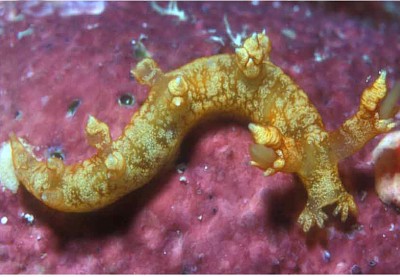
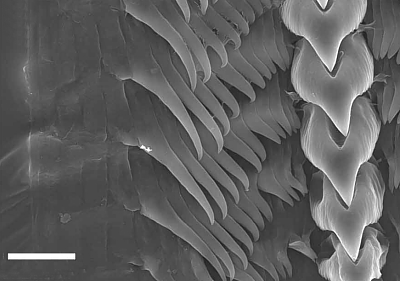
Bornella johnsonorum
Pola, Rudman & Gosliner, 2009
Order: NUDIBRANCHIA
Suborder: DENDRONOTINA
Family: Bornellidae
DISTRIBUTION
Tropical Indo-West Pacific [Marshall Islands, W. Pacific - Pola et al, 2009; Reunion Id., Indian Ocean - see Forum messages]
PHOTO
Upper: Marshall Islands, Oceanside Ennubuj-Ennylabegan reef, Kwajalein Atoll. Photo: J. Johnson. Lower: SEM of left half-rows of radular teeth (CASIZ 175405). Scale bar = 20 µm. SEM Photo: M. Pola.
The elongate body is similar in shape to other species of Bornella. The background color is a translucent straw colour with the to orange-brown viscera showing through. Epidermal and sub-epidermal white spots and patches of varying sizes are scattered all over the body wall. In some specimens, a faint, diffuse orange reticulation is visible around the whitish patches. The oral tentacles on each side of the mouth are lobe-like and have up to 9 finger-like papillae arranged along the margin.
The rhinophore stalks are relatively large with 3 or 4 small papillae placed around the front and sides of the rhinophore sheath and a large unbranched posterior papilla, which when extended, is about three times taller than the other papillae. The rhinophore complex is coloured as the rest of the body except that the the tall posterior papilla on each sheath, is mostly white. The rhinophores are translucent white with a minute orange tip.
There are five to six pairs of dorso-lateral processes, with one or two small, unpaired processes near the tail. The first dorso-lateral process on each side has two or three secondary papillae on the outer side while the second and third processes on each side have a single outer secondary papillae. Behind these there are no secondary papillae. Small tripinnate gills can occur on the inner surfaces of all processes, but can be absent, and usually are smaller on the posterior ones. The lateral papillae are predominantly white and lack subapical orange rings. It grows to at least 20 mm in length.
Although Bornella johnsonorum is very similar to B. stellifer, external and internal features can distinguish both species. In color, Bornella johnsonorum lacks the orange subapical rings found on the papillae of the oral tentacles, rhinophore sheaths and dorso-lateral processes of B. stellifer. Internally, there are differences in aspects of the radula, alimentary canal and reproductive system.
This species is known only from specimens collected in the Marshall Islands by Scott and Jeannette Johnson after whom the species is named. It was found at night in ledges and caves at depths ranging from eight to 15 m.
- Pola, M., Rudman, W. B. & Gosliner, T. M. (2009) Systematics and preliminary phylogeny of Bornellidae (Mollusca: Nudibranchia: Dendronotina) based on morphological characters with description of four new species. Zootaxa, 1975, 1-57.
Rudman, W.B., 2009 (January 27) Bornella johnsonorum Pola, Rudman & Gosliner, 2009. [In] Sea Slug Forum. Australian Museum, Sydney. Available from http://www.seaslugforum.net/find/bornjohn
Related messages
Bornella johnsonorum from Reunion Island [2]
January 28, 2009
From: Philibert Bidgrain
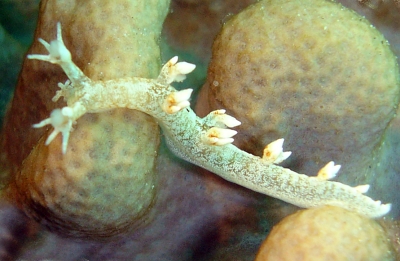
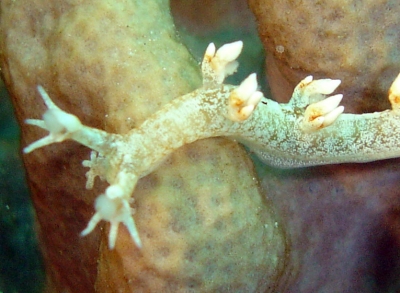
Concerning message #22194:
Dear Bill,
In Réunion Island we also find this Bornella which looks like Bornella stellifer. Do you think that it could this species???
Reunion Island, Indian Ocean. Length: 20 mm
Bests regards
Philibert Bidgrain
http://seaslugs.free.fr/index.htm
pbidgrain@yahoo.fr
Bidgrain, P., 2009 (Jan 28) Bornella johnsonorum from Reunion Island [2]. [Message in] Sea Slug Forum. Australian Museum, Sydney. Available from http://www.seaslugforum.net/find/22196Dear Philibert,
This is the same species as in Sully Bachel's message [#22188] which I am pretty sure is the new B. johnsonorum. It is very interesting to be able to extend the geographic distribution of a new species so quickly. Of course we would need to study its anatomy to be 100% sure, but externally I can see no real differences.
Best wishes,
Bill Rudman
Bornella johnsonorum from Reunion Island [1]
January 28, 2009
From: Sully Bachel
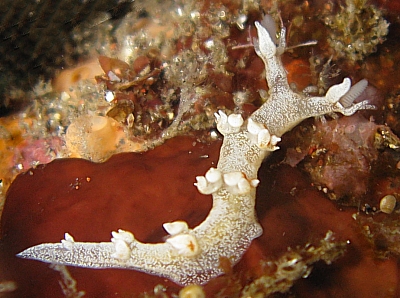
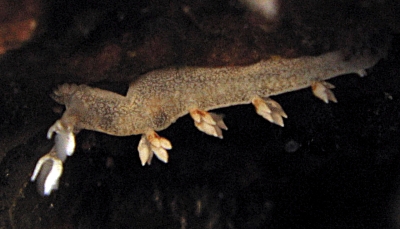
Dear Bill
Two Bornella in a small area, one on a hole. Is it a form of Bornella stellifer? The white points are probably a local particularity.
Locality: Anse des Cascades, 11 m, Reunion Island, Indian Ocean, 11 November 2008. Length: 15 mm. Photographer: Sully Bachel.
Best regards
Sully Bachel
s.bachel@orange.fr
Bachel, S., 2009 (Jan 28) Bornella johnsonorum from Reunion Island [1]. [Message in] Sea Slug Forum. Australian Museum, Sydney. Available from http://www.seaslugforum.net/find/22188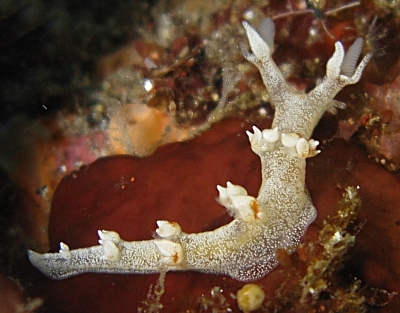
Dear Sully,
I am pretty sure this is Bornella johnsonorum, which as I noted yesterday [message #22194] is only a few days old! The colour and shape of the dorso-lateral mantle processes fit exactly. Considering it was known only from the Marshall Islands in the tropical north Pacific, this is a huge range extension to the western Indian Ocean
It is probably appropriate to mention Bornella simplex Eliot, 1904 which was described from Zanzibar, also in the western Indian Ocean. Eliot described the animal as transparent with an orange network on the back but without orange rings on the tips of the dorsolateral processes. He also described the rhinophore sheaths as bearing six short digitations and a larger rounded knob behind. The remaining description is poorly detailed and the reproductive system was not described. The only unique feature for the species is that rather than having digitate lobes, the oral tentacles are short and simple. As Eliot stated that this character could be a monstrosity, and gave no drawings of the living animal, and no type material can be found, this species is almost certainly unidentifiable.
Eliot (1904) also tentatively identifed another specimen from Zanzibar as Bornella excepta Bergh, 1884 but as Eliot gave no good description of his specimens, and as Bergh gave no description of the colour of the live animal, and as no type specimen exists, Bornella excepta is unidentifiable as well.
-
Bergh, L.S.R. (1884) Report on the Nudibranchiata dredged by H.M.S. Challenger during the years 1873–1876. Challenger Reports, Zoology, 10, 1–154, pls. 1–14.
-
Eliot, C. (1904) On some nudibranchs from east Africa and Zanzibar. Part V. Proceedings of the Zoological Society of London, 2, 83–105, pls. 3–4.
Thanks for this nice find
Best wishes,
Bill Rudman
